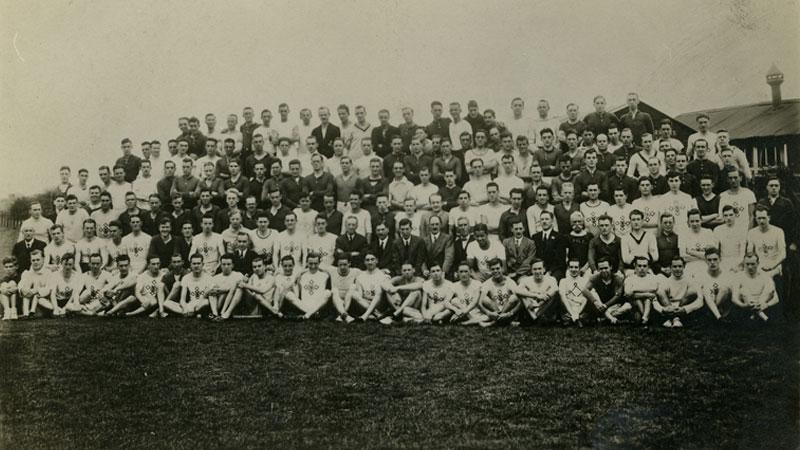The Polytechnic Harriers Athletic Club at Regent Street Polytechnic, which was the University of Westminster’s predecessor that had both an education arm and a sporting and social arm, was established in 1882 and hosted an array of exceptional athletes. The Club’s history has rich connections to the Olympic Games of the 20th century, and the achievements of Harriers’s Black Olympians were key to the Club’s success and high-profile status.

The Polytechnic’s 40-acre Quintin Hogg Memorial Ground at Chiswick opened in 1906. In 1908, the Harriers were invited to organise the trial race for the marathon, which was to be introduced into the Olympic Games in London in 1908. The race, which was planned by Secretary of the Harriers Jack Andrew and the first of its kind to be run in the UK, was run over 23 miles from Windsor Castle to Wembley Park.
The Harriers organised the first inter-club competition in 1893, and by 1914 the Club had established 11 world records. At its peak in 1929, the Harriers had over 800 members.
Four key athletes of the Club, who became key parts of our University’s and indeed British history, were Arthur Wint, John E London, Emmanuel McDonald Bailey and Harry Edward.
Arthur Wint, the gentle giant
Known as the ‘gentle giant’ because of his 198 cm height, Arthur Wint was born in Jamaica in 1920 and was a successful athlete from a young age. Before joining the Polytechnic Harriers, Wint already held a number of sporting achievements, including being named Jamaica Boy Athlete of the Year at the age of 18 and winning gold in the 800-metre sprint at the Central America Games in Panama. In 1942, he was sent to Britain for active combat as a pilot in the British Commonwealth Air Training Plan, which was when he joined the Polytechnic Harriers.
In 1948, Wint took part in his first Olympic Games in London and was selected for the Jamaican track team, competing in three different events. He was hugely successful, winning gold for the 400-metre dash, silver for the 800-metre run and almost had success in the 4x400-metre relay but got cramp during the race. Wint’s gold medal was Jamaica’s first Olympic gold, making his success even more poignant.
In 1952, he also competed in the Olympics in Helsinki, where he achieved the silver title in the 800-metre run and was part of the 4x400-metre relay team who broke the world record with their time of 3.03.09.
Wint was inducted into the Black Athletes Hall of Fame in the USA in 1977 and the Jamaica Sports Hall of Fame in 1989.
John E London, the sprinter of the highest class
Regarded as a sprinter of the highest class, John London possessed great natural sprinting abilities and had a short but successful sporting career. London competed in the 1928 Olympics in Amsterdam, equalling the Olympic 100-metre sprint record of 10.6 seconds in the semi-final and securing the silver medal. He also won the bronze medal in the 4x100-metre relay race with his teammates Cyril Gill, Edward Smouha and Walter Rangeley, behind the USA and Germany teams.
In the same year, London was also awarded the Polytechnic Harriers’s S.A Mussabini memorial medal for his athletic achievements and the Studd Trophy which was awarded annually within the Regent Street Polytechnic for the best athletic performance or series of performances by a Poly athlete.
In 1929, he became the first British sprinter to win the Amateur Athletic Association’s 100-yards race title as well as winning the Kinnaird 100 several times.
Emmanuel McDonald Bailey, the unbeaten
Emmanuel McDonald Bailey was an impressive runner born in 1920 in Trinidad. He moved to Britain as a member of the Royal Air Force in 1944, joining the Polytechnic Harriers in August 1945 and was first awarded the Studd Trophy in 1946.
Bailey ran at the Royal Air Force athletic championships in 1945 and was crowned champion in both the 100-yard and 220-yard events. He dominated these championships for four consecutive years, winning both sprints on each occasion. He remained the unbeaten titleholder until he left the Royal Air Force in 1948.
Bailey took part in the Olympics for the first time in 1948 in London, but after suffering from major athletic injuries in the year previous, he had to fight tenaciously to reach the final of the 100-metres event, in which he finished sixth and last.
Soon after the 1948 Olympics, Bailey fully recovered and saw his biggest sporting achievement in 1949 in Reykjavik, where he recorded times like 9.5 seconds for the 100-yards event and 10.2 seconds for the 100-metres event. Bailey returned to the Olympics with Team GB in 1952 in Helsinki, where he won the bronze medal in the 100-metre Men’s race.
Harry Edward, the United Nations relief worker-turned Olympian
Born in Berlin in 1895, Harry Edward immigrated to London after World War I and taught French and German at Pitman’s School of Business and Civil Service Training. While in London, he joined the Polytechnic Harriers Athletic Club and began his career as a track and field athlete.
In the 1920 Olympic Games in Antwerp, Edward ran for Great Britain and won bronze medals in the 100 and 200-metre sprints. In 1921, he received the Harvey Memorial Gold Cup as the best champion of the year in London, and won three Amateur Athletic Association championships in 1922 in the 100, 220 and 440-yard dashes, receiving personal congratulations from King George V.
In 1923 he decided to try his fortune in the United States and participated in the Wilco Games at Yankee Stadium in New York, as well as taking part in athletic events that the New York and Boston Athletic Clubs sponsored.
Following his athletic career, Edward later committed his time to humanitarian and civil rights causes and worked as a United Nations relief worker.
Find out more information on the University of Westminster Archive website.







